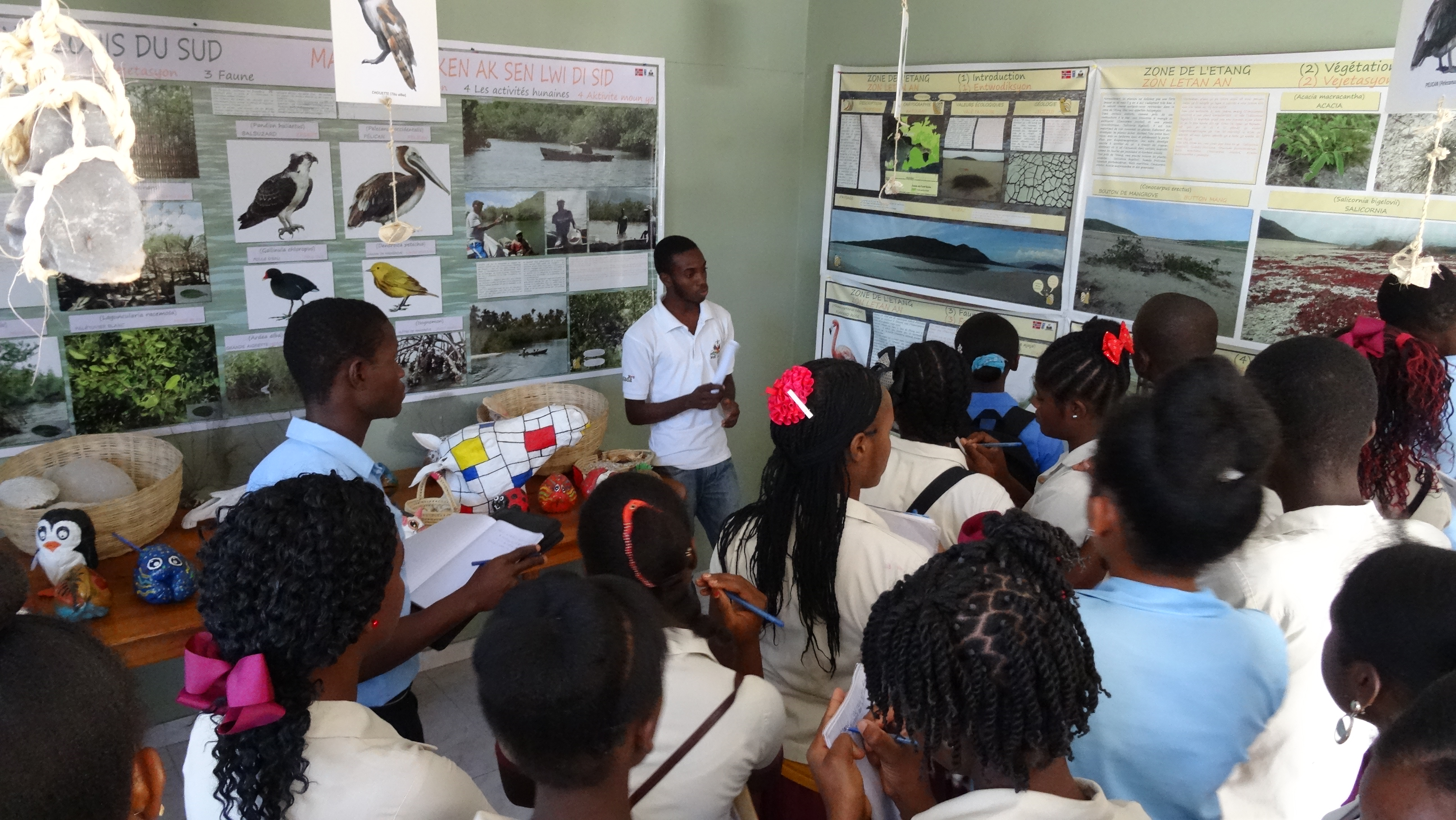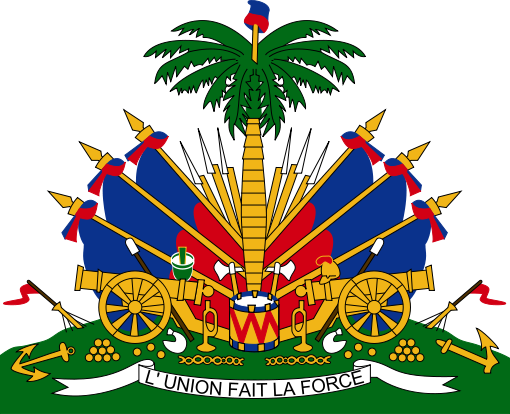Strengthening Adaptive Capacities of Coastal Communities in Haiti
Project Overview
Haiti has recently been identified as one of the country’s most vulnerable to the impacts of climate change. The country is subject to a broad range of natural threats: droughts, hurricaines, tsnuamis, and earthquakes. In recent years, the country has been afflicted by a significant increase in the occurrence of severe natural disasters. These observations have been confirmed by the alarming trend in successive disasters including 20 major disasters in the 20th century, 4 of which occured in the last decade alone.
Haiti's National Adaptation Programme of Action (NAPA) identified the coastal development sector as a top national priority for climate change adaptation. In response, this UNDP-supported, GEF-LDCF financed project is developing a programmatic approach to support climate risks management (CRM) in the most vulnerable Low-Elevation Coastal Zones (LECZ) of Haiti.
The project aims to promote development that protects the local communities from climate change impacts. This includes creating resilient economies and societies while reducing risks for vulnerable populations in Haiti. In the aftermath of the rebuilding effort that is currently ongoing, one of the main goals of the government is to strengthen institutional capacities to support shifts toward resilient economies and societies possible.
Project Details
Haiti has the second longest coastline of any country in the Antilles, therefore, is highly susceptible to impacts of sea level rise. Anticipated increases in sea levels and sea surface temperatures are also likely to be primary causes for increased beach erosion, salinization of fresh water aquifers and estuaries, coastal erosion and increased coral reef bleaching throughout the island. The combination of environmental destruction and other factors such as weak institutions, extreme poverty and rapid population growth raise the risk of new challenges in the island republic.
Haiti has remains the only least-developed country in the Americas. Comparative social and economic indicators show Haiti falling behind other low-income developing countries (particularly in the hemisphere) since the 1980s. Haiti now ranks 155th of 177 countries in the United Nations Human Development Index (HDI). About 80% of the population were estimated to be living in poverty in 2003. Economic growth was negative in 2001 and 2002, and flat in 2003. These socio-economic factors translate to the communities, networks and governments having a very low capacity to adapt to climate changes.
The project aims to promote development that protects the local communities from climate change impacts. This includes creating resilient economies and societies while reducing risks for vulnerable populations in Haiti. In the aftermath of the rebuilding effort that is currently ongoing, one of the main goals of the government is to strengthen institutional capacities to support shifts toward resilient economies and societies possible. In short, Haiti would have integrated climate change risk management into development solutions including:
- Public policy, legislative and institutional reform promoted to proactively manage climate change risks.
- National and sub-national climate change governance structures strengthened to enhance coordination.
- Policy and fiscal instruments for adaptation developed, including changes in incentives and adjustments in national budgets.
- Market instruments for promoting autonomous adaptation, including expanding markets and promoting market access for the poor, and market diversification.
- Development finance from multilateral and bilateral funds, as well as alternative sources of financing accessed in light of anticipated adaptation costs to effectively meet national costs.
- Global, regional, national, sub-national knowledge from good practices learned from experiences codified, shared and replicated.
Additionally, the NAPA has identified eight priority actions to be implemented immediately, which cover the vulnerable groups in the above-mentioned sectors. The priority actions include:
- Priority 1: Watershed and grounds conservation
- Priority 2: Coastal zone management
- Priority 3: Promote and preserve of natural resources
- Priority 4: Preserve and enhance food safety
- Priority 5: Protect and conserve water
- Priority 6: Construct and rehabilitate infrastructure
- Priority 7: Manage wastePriority 8: Raise awareness through education and information dissemination
Information taken from UNDP Haiti Project Document submitted February 21st, 2011
Key Results and Outputs
Outcome 1: Institutional capacity to plan for and respond to increasing coastal hazards improved
- Output 1.1: develop management skills of National Systems for Risk and Disaster Management (SNGRD) in coordination with key sectoral agencies (agrifuclture, CIAT, etc.), such as developing effective early warning systems, mapping vulernable areas, determining effective evacuation strategies, and implementing improved post disaster recovery methods to facilitate a shift from a reactive approach to managing climate disaters to a proactive approach.
- Output 1.2: Integrate cost-effective standards into official Haitian guidelines for emergency food utilization regarding climate change adaption
- Output 1.3: Strengthening the CIAT to integrate climate change adaption into watershed planning of coastal municipalities
- Output 1.4: Establish a data sharing network to provie processed and accurate climate information to the producers of the raw data and to the end users
Outcome 2: Climate risks management is fully mainstreamed into humanitarian and development investment frameworks
- Output 2.1: Support MFE in developing a methodology to integrate climate change costs into the institutional budgets
- Output 2.2: Assist the MPCE in designing a national programmatic strategic framework for climate change adaptation to guide bilateral and multilateral cooperation in and around coastal areas
Outcome 3: Resilience of low-elevation coastal zones to emerging climate change threats enhanced
- Output 3.1: enabling condition established to build the claimte resilenceof the water sector in the Coastal Areas of the South-East Department (DINEPA)
- Output 3.2: enabling climate change adaption conditions established to improve watershed resilence and tolerance to claimte change-related drought in the coasta areas of the Souther Department (CNIGS/CNSA).
Outcome 4: Models of best practices and lessons learned from the project activities captured and institutionalized
- Output 4.1: dissemination of toolkit, knowledge products and guidance materials on climate-resilient coastal development to key agencies, munipalities and local communities
- Output 4.2: Thematic programs on climate risk data management developed within the CNIFS, ONEV, CIAT
- Output 4.3: Project website developed as a knowledge platform
- Output 4.4: Project lessons prepared for dissemination through the Adaptation Learning Mechanism (ALM)
Information taken from UNDP Haiti Project Document submitted February 21st, 2011
Reports and Publications
Project Brief / Fact Sheet
Project Brief: Strengthening Adaptive Capacity to Address Climate Change Threats on Sustainable Development Strategies for Coastal Communities in Haiti (2015)
Case Study
Case Study: The Use of Geographic Information Systems (GIS) to Guide Interventions related to Climate Change Adaptation in Haiti
Étude de Cas: Utilisation du Système d'Information Géographique pour Guider les Interventions Relatives à l'Adaptation aux Changements Climatiques à Haïti
Highlights
Second Radio Spot for Newly Launched Song by Atis Pou Anviwonman
Radio Spot for Newly Launched Song by Atis Pou Anviwonman
Brochures, Posters, Communications Products
Multimedia
Music Video: Nou an danje - Atis pou anviwonman
This song and music video was produced by the LDCF funded project in Haiti. It brings together Haitian artists, known as Artists of the Environment, to produce a song that discusses the dangers and challenges of climate change.
Canada-UNDP Climate Change Adaptation Facility: Experiences from Haiti
This photostory provides an illustration of the activities undertaken and results achieved to date under the Canada-funded project in Haiti. This project is implemented alongside the LDCF project on strengthening adaptive capacities of coastal communities, as well as building on the Vulnerability South project funded by Norway. It aims to scale up good practices and concrete results to reach more beneficiaries in the Southern Region of Haiti.
Monitoring and Evaluation
Project Start:
- Project Inception Workshop: will be held within the first 2 months of project start with those with assigned roles in the project organization structure, UNDP country office and where appropriate/feasible regional technical policy and programme advisors as well as other stakeholders. The Inception Workshop is crucial to building ownership for the project results and to plan the first year annual work plan.
Quarterly:
- Project Progress Reports (PPR): quartlerly reports will be assembled based on the information recorded and monitored in the UNDP Enhanced Results Based Managment Platform. Risk analysis will be logged and regulary updated in ATLAS.
Annually:
- Annual Project Review/Project Implementation Reports (APR/PIR): This key report is prepared to monitor progress made since project start and in particular for the previous reporting period (30 June to 1 July). The APR/PIR combines both UNDP and GEF reporting requirements.
Periodic Monitoring through Site Visits:
- UNDP CO and the UNDP RCU will conduct visits to project sites based on the agreed schedule in the project's Inception Report/Annual Work Plan to assess first hand project progress. Other members of the Project Board may also join these visits. A Field Visit Report/BTOR will be prepared by the CO and UNDP RCU and will be circulated no less than one month after the visit to the project team and Project Board members.
Mid-Term of Project Cycle:
- Mid-Term Evaluation: will determine progress being made toward the achievement of outcomes and will identify course correction if needed. It will focus on the effectiveness, efficiency and timeliness of project implementation; will highlight issues requiring decisions and actions; and will present initial lessons learned about project design, implementation and management. Findings of this review will be incorporated as recommendations for enhanced implementation during the final half of the project’s term.
End of Project:
- Final Evaluation: will take place three months prior to the final Project Board meeting and will be undertaken in accordance with UNDP and GEF guidance. The final evaluation will focus on the delivery of the project’s results as initially planned (and as corrected after the mid-term evaluation, if any such correction took place). The final evaluation will look at impact and sustainability of results, including the contribution to capacity development and the achievement of global environmental benefits/goals. The Terminal Evaluation should also provide recommendations for follow-up activities.
- Project Terminal Report: This comprehensive report will summarize the results achieved (objectives, outcomes, outputs), lessons learned, problems met and areas where results may not have been achieved. It will also lay out recommendations for any further steps that may need to be taken to ensure sustainability and replicability of the project’s results.
Learning and Knowledge Sharing:
- Results from the project will be disseminated within and beyond the project intervention zone through existing information sharing networks and forums.
- The project will identify and participate, as relevant and appropriate, in scientific, policy-based and/or any other networks, which may be of benefit to project implementation though lessons learned. The project will identify, analyze, and share lessons learned that might be beneficial in the design and implementation of similar future projects.
- Finally, there will be a two-way flow of information between this project and other projects of a similar focus.
Information taken from UNDP Haiti Project Document submitted February 21st, 2011
Contacts
- Supporting, technically, 1084 farmers (336 women, 748 men) with on-site training on soil conservation, composting, mangoes grafting, seeds treatment (cassava, sweet potato, peas strain, mil), irrigation techniques and water conservation;
- Giving technical support to these farmers on reforestation good practices and on pluri-culture gardening plots;
- Giving training to these farmers on veterinary techniques such as genetic improvement of goats.
- Giving training and technical support to these farmers to implement activities of beekeeping;








